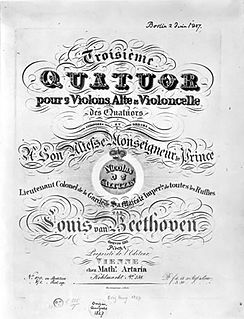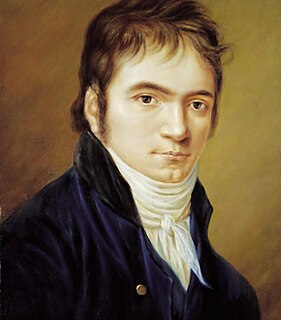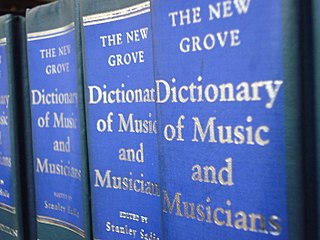
A metronome, from ancient Greek μέτρον and νέμω, is a device that produces an audible click or other sound at a regular interval that can be set by the user, typically in beats per minute (BPM). Musicians use the device to practice playing to a regular pulse. Metronomes typically include synchronized visual motion.
A click track is a series of audio cues used to synchronize sound recordings, sometimes for synchronization to a moving image. The click track originated in early sound movies, where optical marks were made on the film to indicate precise timings for musical accompaniment. It can also serve a purpose similar to a metronome, as in the music industry, where it is often used during recording sessions and live performances.
The Rhapsody on a Theme of Paganini, Op. 43, is a concertante work written by Sergei Rachmaninoff. It is written for solo piano and symphony orchestra, closely resembling a piano concerto, albeit in a single movement. The work was written at his summer home, the Villa Senar in Switzerland, according to the score, from July 3 to August 18, 1934. Rachmaninoff himself, a noted interpreter of his own works, played the solo piano part at the piece's premiere at the Lyric Opera House in Baltimore, Maryland, on November 7, 1934 with the Philadelphia Orchestra, conducted by Leopold Stokowski. Rachmaninoff, Stokowski, and the Philadelphia Orchestra made the first recording, on December 24, 1934, at RCA Victor's Trinity Church Studio in Camden, New Jersey.
This is a list of musical terms that are likely to be encountered in printed scores, music reviews, and program notes. Most of the terms are Italian, in accordance with the Italian origins of many European musical conventions. Sometimes, the special musical meanings of these phrases differ from the original or current Italian meanings. Most of the other terms are taken from French and German, indicated by "Fr." and "Ger.", respectively.

The Symphony No. 1 in E minor, Op. 39, by Jean Sibelius is a symphony started in 1898, and finished in early 1899, when Sibelius was 33. The work was first performed on 26 April 1899 by the Helsinki Philharmonic Orchestra, conducted by the composer, in an original version which has not survived. After the premiere, Sibelius made some revisions, resulting in the version performed today. The revised version was completed in the spring and summer of 1900, and was first performed in Berlin by the Helsinki Philharmonic, conducted by Robert Kajanus on 1 July 1900.
The Symphony No. 10 in E minor by Dmitri Shostakovich was premiered by the Leningrad Philharmonic Orchestra under Yevgeny Mravinsky on 17 December 1953, following the death of Joseph Stalin in March of that year. It is not clear when it was written: according to the composer's letters composition was between July and October 1953, but Tatiana Nikolayeva stated that it was completed in 1951. Sketches for some of the material date from 1946.

The String Quartet No. 13 in B♭ major, Op. 130, by Ludwig van Beethoven was completed in November 1826. The number traditionally assigned to it is based on the order of its publication; it is actually Beethoven's 14th quartet in order of composition. It was premiered in March 1826 by the Schuppanzigh Quartet and dedicated to Nikolai Galitzin on its publication in 1827.

Ludwig van Beethoven's Symphony No. 1 in C major, Op. 21, was dedicated to Baron Gottfried van Swieten, an early patron of the composer. The piece was published in 1801 by Hoffmeister & Kühnel of Leipzig. It is not known exactly when Beethoven finished writing this work, but sketches of the finale were found to be from 1795.
Pyotr Ilyich Tchaikovsky's Trio in A minor, Op. 50, was written in Rome between December 1881 and late January 1882. It is subtitled « À la mémoire d’un grand artiste » - In memory of a great artist, in reference to Nikolai Rubinstein, his close friend and mentor, who had died on 23 March 1881. It is scored for piano, violin, and cello.
Tempo rubato is a musical term referring to expressive and rhythmic freedom by a slight speeding up and then slowing down of the tempo of a piece at the discretion of the soloist or the conductor. Rubato is an expressive shaping of music that is a part of phrasing.
The Variations on a Nursery Tune, Op. 25, is a piece for piano and orchestra by Ernő Dohnányi. It is subtitled For the enjoyment of humorous people and for the annoyance of others.
The Trio No. 1 in B-flat major for piano, violin, and cello, D. 898, was written by Franz Schubert in 1827. The composer finished the work in 1828, in the last year of his life. It was published in 1836 as Opus 99, eight years after the composer's death. Like the E-flat major trio, it is an unusually large scale work for piano trio, taking around 40 minutes in total to perform.
Sergei Prokofiev's Violin Sonata No. 2 in D Major, Op. 94a, was based on the composer's own Flute Sonata in D, Op. 94, written in 1942 but arranged for violin in 1943 when Prokofiev was living in Perm in the Ural Mountains, a remote shelter for Soviet artists during the Second World War. Prokofiev transformed the work into a violin sonata at the prompting of his close friend, the violinist David Oistrakh. It was premiered on 17 June 1944 by David Oistrakh and Lev Oborin.

Leonard Bernstein's Symphony No. 2 The Age of Anxiety is a piece for orchestra and solo piano. The piece was composed from 1948 to 1949 in the US and Israel, and was revised in 1965. It is titled after W. H. Auden's poem of the same name, and dedicated to Serge Koussevitzky.
Variations on a Theme of Corelli, Op. 42, is set of variations for solo piano, written in 1931 by the Russian composer Sergei Rachmaninoff. He composed the variations at his holiday home in Switzerland.
Dmitry Kabalevsky's Preludes, Op. 38 are a set of 24 piano pieces in the Chopinian model, each based on a folksong and each in a different key. It was composed in 1943–44, and dedicated to Nikolai Myaskovsky, his teacher. It is one of a number of examples of music written in all 24 major and minor keys.
Tempo giusto is a musical term that means “in exact time”, often directing a return to strict time following a period of rubato. or to play in “strict time” or “suitable time”.
The String Quartet No. 2 in F major, Op. 22, by Pyotr Ilyich Tchaikovsky, was composed between December 1873 and January 1874.
Fifteen Hungarian Peasant Songs, Sz. 71, BB 79 is a collection of short folk melodies arranged for piano by Hungarian composer Béla Bartók. It was composed between 1914 and 1918.
4 Pièces caractéristiques by Clara Schumann was composed between 1834 and 1836, and published in 1836. The entire work is labeled as opus 5, and is written for solo piano. The pieces are as follows.







